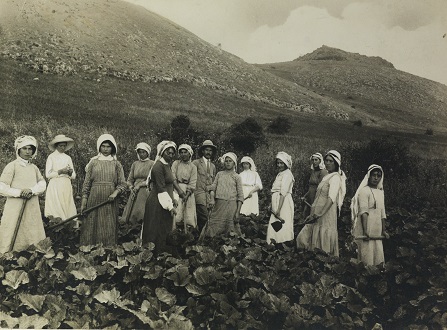The Second Aliyah
The “Second Aliyah” was the second mass wave of Jewish immigrants to arrive in the Land of Israel as part of Shivat Zion (the "Return to Zion"), which began in 1904 and lasted until the outbreak of WWI in 1914. During this decade, about 35,000 immigrants arrived, the vast majority coming from Eastern Europe, with a minority arriving from Yemen. Like the First Aliyah, the Second Aliyah took place on the backdrop of a global migration movement from Eastern to Western Europe, as well as to the Americas and Australia. Many of these immigrants were Jews, though only a minority chose to make their way to the Land of Israel. The scope of the Second Aliyah intensified with manifestations of antisemitism and pogroms that swept Eastern Europe.
The immigrant population was composed of four main groups: immigrants who joined the "Old Yishuv" (traditional Jewish communities based mainly in the cities of Jerusalem, Hebron, Tiberias and Safed); immigrants who settled in the new farming colonies and in new neighborhoods being built in various towns or cities; immigrants from Yemen, about half of whom went to work in the farming settlements; and young people from Eastern Europe who hoped to create a new Zionist national society in the country.
The Pioneers Who Left Their Mark
Most of the immigrants of the Second Aliyah joined the Old Yishuv or settled in the new neighborhoods being built at the time. The population increase in the cities led to impressive urban development, with the most prominent being the establishment of Tel Aviv, which began as a neighborhood of Jaffa. Jerusalem and Haifa also received a boost with the development of new neighborhoods and important public institutions.
While the number of young ideological pioneers was relatively low, they left a deep imprint on Zionist history and produced a generation of leaders for the Hebrew settlement and eventually the State of Israel. They established the first communal agricultural settlements, which began as cooperative farms and developed into kibbutzim and moshavim.
An idea that took shape in those years called for the employment of immigrants in agriculture, in the belief that “Hebrew labor” was essential to national revival. In practice, however, there was friction between the immigrant workers and their employers, and many farmers continued to use Arab workers. Another ideology advocated Jewish defense of the settlements, which led to the establishment of the Bar Giora group that later became the Hashomer organization.
The difficult economic situation in the country and the poor living conditions dashed the hopes of many, leading to widespread frustration among the immigrants. It is estimated that at least half left the country within a few years. At the end of the period, the Jewish community numbered about 80,000 people.
The fascinating and complex story of the Second Aliyah is reflected in an abundance of archival materials preserved in the National Library, including many rare photographs, postcards, documents, letters, poems, books, posters and press clippings. These items provide an interesting and enriching picture of the faces and names of the people and leaders of the Second Aliyah, the settlement enterprise and its achievements as well as its difficulties, mistakes and conflicts.




